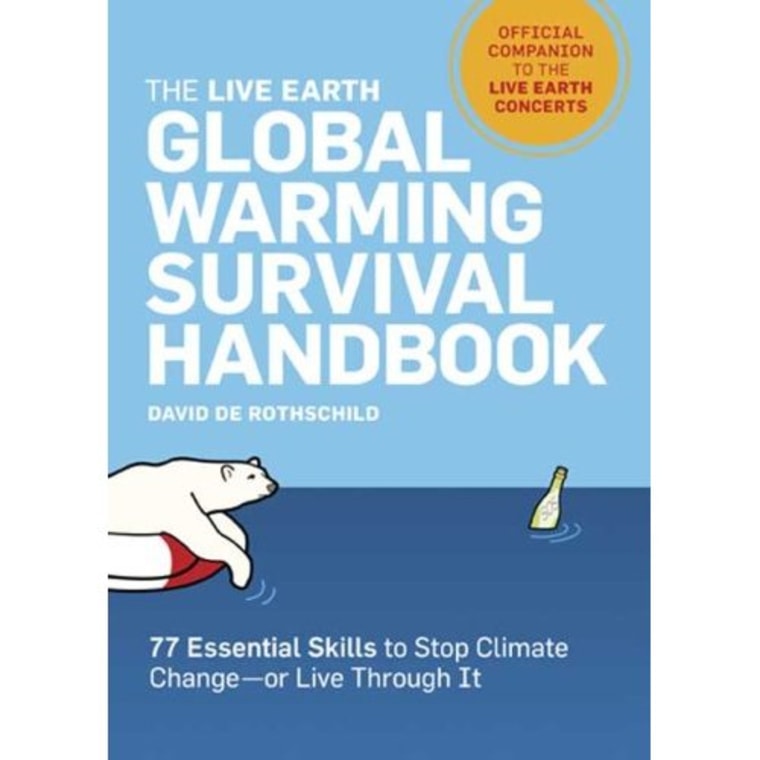In "The Live Earth Global Warming Survival Handbook," adventurer and environmentalist David de Rothschild basically provides the idiot's guide to saving the planet. Written in a fun, lighthearted style, the book lists 77 tips or skills that people can use to help stop climate change. The handbook is a companion book to the Live Earth concert, a 24-hour, seven-continent concert series taking place on Saturday, July 7, to raise awareness about global warming.
Here are a few tips from David de Rothschild that can help people save money as well as be environmentally friendly:
Replace a Lightbulb
If one million homes replaced four of their traditional incandescent bulbs with Energy-Star approved compact fluorescent bulbs (the ones that look like soft-serve ice cream cones), 900,000 tons of greenhouse gasses would be eliminated, and people would save approximately $30 to $50 dollars in electricity over the life of the bulb for each bulb they replace.

TV's and VCR's in standby mode waste an estimated $1 billion dollars in electricity each year, but if one million households halved their phantom power load, we'd eliminate 150,000 tons of carbon dioxide a year.
Put On a Sweater
By lowering your thermostat by just 2 degrees in the winter, you'll save up to 4% on your energy bill, and prevent 500 lbs. of carbon dioxide from entering the atmosphere. Plus, as David writes, the more people who wear sweaters, the happier Jimmy Carter will be.
Paper or Plastic? Neither!
We've long been told to ask for paper instead of plastic bags at the grocery store, but the truth is, although paper bags are biodegradable, the waste of resources used to produce them makes paper almost as big a drain on the environment as plastic bags are. What to do? While paper is still preferable to plastic, the best option is to bring your own reusable bags to the grocery store, be they canvas or nylon or hemp, and skip paper or plastic altogether.
Lobby Your Hotel
In a given year, a single hotel room uses more than 80,000 gallons of water and generates 5 tons of garbage. Given that there are approximately 3.3 million hotel rooms in the U.S., hotels generate a lot of waste, and that's not even counting the near-continual use of air conditioning in every room. How do we do our part? Many hotels now offer guests the option to use one set of linens and towels during their stay. If one million people used just one set of linens for a week, it would save 1.5 million gallons of water.
Build a Straw Home
Building a home using straw insulation instead of traditional building materials will cut heating and cooling costs, reducing your energy usage by two-thirds. If one million households halved their gas-heating bill, 2.75 million tons of carbon dioxide would be eliminated per year.
Harvest the Sun
If one million homes installed solar panels on their roof and switched to solar power, we could reduce C02 emissions by 4.3 million tons a year. Currently, it is an expensive investment, costing over $20,000 to install solar panels on the roof of your home. However, homeowners can save potentially hundreds or even thousands of dollars a year in electricity costs; most people will still be connected to the power grid, and will simply use the traditional electricity as auxiliary power.
Install a Windmill
If 100,000 homes installed and relied on wind power, C02 production could be reduced by 900,000 tons. The cost of installing a wind turbine starts at $7,000, and an average wind speed of 10mph is required to generate an adequate amount of power.
Drive a Frybrid
For between $500 and $1000, you can convert the engine your old Mercedes diesel sedan to run on used french-fry grease (aka vegetable oil). According to David, more than one million gallons of fuel could be made from waste vegetable oil collected from restaurants in San Francisco alone.